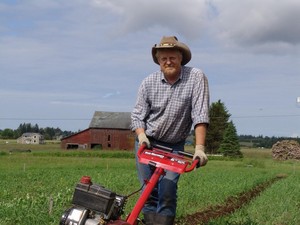19 Dec Fri 2008
Introduction to F.A. Farm and the Dual Track Sustainable Model
OK - Here goes. Our farm is called F.A. Farm and the F.A. stands for Full Attention. It also stands for Fresh, Absolutely! or any of a dozen other phrases. We produce sustainably-grown fruits and vegetables for retail sale and are also moving into sustainable grain production. What I mean by sustainable is basically "beyond organic." All of us farmers are on the same continuum, since we are producing new wealth in the form of food. However, some of us use very little petroleum-based products, while others use massive amounts, whether it is in the form of embedded calories in equipment, massive quantities of diesel, or chemical fertilizers. Yet I also use petroleum products when I put gas in my tiller and drive my pickup to the farmers market to sell my produce. We can't be pure, but we can reduce our carbon calorie usage by a considerable amount. Thus, the idea of being on the same continuum. I am more sustainable than my neighbors, but it is not an either-or proposition.
As an example of the economics of sustainable agriculture, I don't sell dry beans because I would have to charge $30 a pound for what I actually do with them. However, with crops I am not selling I do a barter U-pick. I grow them, you pick them and I get half the yield. This has worked good so far on wheat, oats, and raspberries. So, if you want dry beans you can come out and pick a 75-foot row, split them with me and shuck your half yourself, while you are sitting about watching TV for instance. It will probably take you 1-2 hours per row to pick the pods. The yield for the whole row would be about 4 pounds but you would get half in the form of a bucket of bean pods to take home and shell. Once you shell them, you will have about 2 pounds of dried beans. So . . . 2 hours in the field and 2 more in front of the TV for 2 pounds of beans. You can see why I don't sell them. By the way, these numbers compare to an independent trial done here in Whatcom County in 2008 where the farmer got 3 cups of beans for 3 hours of labor on average. A cup of dried beans is roughly half a pound, so you are still looking at 2 hours labor for a 1 pound dried beans. If you factor in land rents, fuel costs, capital costs, etc., $30 a pound is in the ball park for the real price of a pound of beans.
You can probably see why I am so hyped on the peak oil problem. Beans are a necessary ingredient in responsible eating (whether it is low meat, vegetarian, or vegan). The only way to do beans economically is in the corporate model, which is dependent on fossil fuel and heavy equipment. In my sustainable model, I figure in the increased calories in dry beans (1500 per pound vs. 300 for green beans - a factor of 5) and the increase in soil fertility from the nitrogen-fixing bacteria, but this cannot really be translated into a dollar value. As a ballpark estimate, I would still have to get $10-15 a pound compared to selling green beans at $3 a pound. However, putting a parallel track into my model allows me to "distribute" beans. The two track model is really what I am doing with informal workshares and barter U-pick. People work and get paid in food. This generates more food and the value of certain crops that build up the soil is part of the process. However, I need another track that brings in cash. Dry beans are on one track, green beans on the other. This dual track allows me to bridge into postmodern agriculture from a modern economy. Another bridge is the CSA share program. By getting money up front, I have operating capital for seeds, fuel, living expenses, etc. and I get an alternative distribution system that also allows me to use the other track for growing more food. I also get more time on the farm, rather than doing deliveries. This dual track model is integral to sustainable agriculture.

